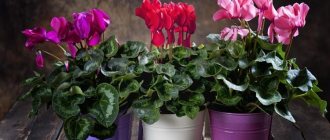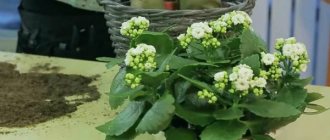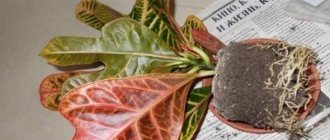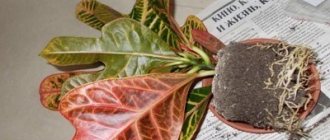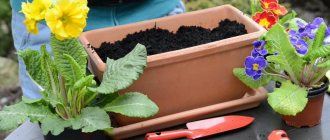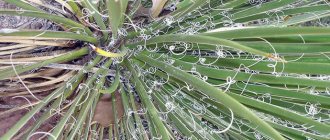- February 6, 2019
- Flowers
- Svetlana Pavlova
Cyclamen (or cyclomenia) is an incredibly beautiful plant. Its magnificent flowers resemble tongues of frozen flame. In any flower shop you can buy a brightly blooming plant all year round. Its unusual appearance attracts both beginners and experienced gardeners. However, in order to avoid difficulties associated with care, you need to familiarize yourself with some nuances. Particular attention should be paid to proper care and replanting after purchasing a cyclomenia flower, otherwise it may die after some time.
Description and types
The popular name of the flower is drakva or alpine violet. Cyclamen is a perennial herbaceous plant that belongs to the Primrose family. Flower shoots (tubers) are round in shape up to 15 cm in diameter. The height of the flower is from 10 to 25 cm and depends on the variety. This plant has no stems. The green leaves with a silvery pattern are heart-shaped. Charming flowers of various shades are located on high peduncles and delight the eye all winter and until spring. There are more than 60 different plant species. For home cultivation, two types of cyclamens are most often used:
- Persian - the plant grows up to 30 cm, the diameter of the tuber is about 15 cm, heart-shaped green leaves with a gray pattern. The flowers are on long stalks and have an elongated shape. It blooms in winter, and in summer the cyclomenia flower shown in the photo does not require care, except for minor watering. During this period it is at rest.
- European - slightly inferior in size to Persian, has a tuber with a diameter of about 10 cm. The leaves on the reverse side are dark red and do not fall off after the end of flowering, which occurs in the summer, and in winter the flower rests.
How to choose the right cyclamen in the store
Of course, you will want to bring a wildly flowering plant into the house, but it is better to take your time and find a bush where most of the buds have not even thought of blooming yet, and the leaves do not have the slightest hint of yellowness.
You need to lift the pot and examine the roots; they can be seen from the bottom of the pot through the hole. No rotten roots!
If the plant’s soil is not transportable, but suitable for the plant, then the tuber of a well-planted flower rises above the soil by a maximum of ⅔ in Persian varieties. European tubers will be completely underground.
Rules for choosing a flower
Before purchasing, you should carefully inspect the plant to make sure there are no damaged or limp leaves. The bush itself must have:
- strong stems;
- be thick and dense;
- the top of the tuber should stick out of the ground.
If the plant blooms, it is better to choose it with a large number of buds. The best time to buy is autumn. If you purchase tubers, they must be healthy. First of all, pay attention to the growth bud. When purchasing, you should give preference to dense and weighty tubers.
Procedures after purchase
After acquiring cyclomenia:
- You need to carefully examine the plant again. If damaged leaves and flowers are identified, remove them.
- The plant is kept in quarantine for some time and treated for preventive purposes.
- All plants purchased in the store require careful care and replanting.
After purchasing a cyclomenia flower, you need to inspect the root system. Replace the substrate, since the transport soil in which the plant arrives at the store is filled with a large amount of fertilizer to maintain it in marketable condition. Often the substrate contains larvae of various pests. When replanting a plant into new soil, you should carefully remove the old one and wash the roots. Often the transplanted plant withers and dies. This occurs after intensive feeding of cyclamen with stimulants, and the plant becomes dependent on them. Therefore, experts give the following advice on care after purchasing and replanting a cyclomenia flower:
- fertilize more often, gradually reducing the dose of fertilizer;
- if rotten areas on a tuber are identified, they must be removed and the cut areas sprinkled with activated carbon;
- The entire tuber should not be buried in the ground; the upper part should stick out of the pot;
- pre-steam or calcinate the purchased soil.
Step by step process instructions
How to transplant homemade cyclamen into another pot - step by step:
Prepare the substrate.- Prepare a new container; if you use an old one, be sure to treat it with potassium permanganate or pour boiling water over it, this is done for disinfection.
- Carefully remove yellowed and dry leaves.
- Carefully remove the plant from the pot and inspect the bulb and roots.
- Dry and rotten roots should be trimmed with clean scissors.
- Since the transplant is carried out into new fresh soil, it is necessary to remove the old soil from the roots as much as possible.
- Next, drainage is poured onto the bottom of the pot and 3-4 centimeters of soil is added.
- Place the flower and add more soil, but do not cover the entire bulb. It should be visible.
- Water the cyclamen thoroughly, but do not get water on the center of the tuber. Drain excess water from the pan.
- Then the flower is put back in place and left alone.
Lighting and temperature conditions
Illumination for cyclamen plays an important role. The flower prefers diffused light, so it is placed on western or eastern windows. Direct sunlight has a detrimental effect on the plant. For the cyclomenia flower shown in the photo, care at home necessarily requires compliance with the temperature regime.
During the flowering period, the optimal temperature is 10–12 degrees. At higher rates, the plant may stop flowering. To create a lower temperature, place the flower on a cold window and regularly ventilate the room. However, it is necessary to ensure that there are no drafts.
How to care after planting?
After transplantation, proper care is important, which includes the following features:
- The pot is placed in a bright place, but so that there is no direct rays of the sun. The temperature should be within +14…+18°C.
- Watering is rare. It is better to pour water into the pan so as not to get on the tuber. The water must be settled.
- After a month, fertilizers are applied.
If you do not adhere to these rules, the cyclamen may die or bloom at the wrong time. After this time, care is no different from usual.
Watering and fertilizers for cyclamen
The flower must be watered regularly with settled water, but stagnation of moisture is detrimental to it. It is best to water in a tray or immerse the container with the plant in water, then it will take the required amount of moisture. Providing moist air is one of the conditions for proper care at home. The cyclomenia flower, the photo of which is posted in the article, does not tolerate dryness and does not like droplets of water falling on the leaves and flowers. Therefore, the air is humidified with a spray bottle or water is poured into a container with pebbles and placed near it. During the flowering period, cyclamen needs to be fed every two weeks. To do this, use liquid fertilizers for flowers, after watering the flower.
When is it time to replant cyclamen?
Cyclamen is often called the alpine violet of the Mediterranean.
The petals of its flowers are compared to the wings of colorful moths gathered over the greenery. After all, it blooms with the most incredible colors and shades: soft scarlet, snow-white, purple, crimson, cherry, apricot and even lilac. The sizes of flowers can be simply huge and generally tiny. A huge number of buds are knocked out with 15 flowers blooming at the same time.
You need to water the flower with settled soft water, on the edge of the container, so that moisture does not get into the growth zone. Watering water on leaf blades and at the point of their germination is also contraindicated.
Cyclamen needs good lighting and ventilation in the room. He also likes cool temperatures - no higher than 15 degrees. Moreover, in such ascetic conditions, cyclamen blooms much longer. But he can’t stand drafts. The plant is especially sensitive to them after transplanting cyclamen. Leaves that have turned yellow after the flowers have withered should be plucked out with your fingers, and not with any devices such as a knife or tweezers. Obsolete leaves should be unscrewed, but as carefully as possible so as not to destroy the growth zone.
On a faded flowerpot, a tuber peeks out from under the ground completely naked. During this period, watering should be significantly limited, but not stopped completely. The best way to water during suspended animation is in a tray. During this time, the pot is placed in the shade. And only with the appearance of young shoots, which usually happens in the summer, but before budding, cyclamen can be replanted.
Replanting is also necessary when the root crops grow so large that they do not fit in the pot, or when depleted soil needs to be replaced. Under no circumstances should flowering cyclamen be replanted.
Cyclamen brought from the store is often also replanted. By pulling the plant out of the pot, you can determine the need for replanting.
If the time of transplantation is chosen correctly, this is already half the success of this delicate matter. Therefore, you should not just do a transplant when the time comes.
Features of caring for cyclamen after flowering
Abundant flowering of cyclamen throughout the winter period depletes it, and by spring the plant needs a long rest. The leaves turn yellow and gradually die, and the tuber becomes bare. Care for the cyclomenia flower after flowering is as follows:
- reduce watering;
- put the flower in a cool and dark place.
The soil in the pot should not dry out; periodically it is necessary to lightly water the plant. Until the end of the summer period, cyclomenia remains in this state. In autumn, in September, the plant enters a new stage, therefore:
- the pot is taken out and put in its original place;
- resume normal watering;
- if necessary, the tuber is replanted, removing damaged roots;
- the plant is fed.
During the dormant period, flower care is very simple, but these rules must be strictly followed. Its further flowering will depend on this.
Possible errors during transplantation
Among the mistakes that are made when changing containers for plants are the following.
- the tubers were damaged when the bush was taken out of the old pot and deeply deepened into new soil during replanting;
- the bulb was very deeply buried. The plant is planted so that a small part of the roots protrudes above the surface of the ground;
- If you choose a pot that is too wide, you will have to wait a long time for flowering. It is necessary to select containers in such a way that the distance from the tuber to the walls of the container is no more than 3 cm;
- the room in which the recently transplanted flower is located is very warm. The culture does not like hot rooms; unadapted cyclamen will turn yellow.
Cyclamen is a delicate plant; it requires careful handling during planting and further care.
Why doesn't it bloom after transplanting?
The plant does not tolerate oversaturation with mineral fertilizers. It is better to make a solution with a lower concentration of nutrients. The first feeding is carried out after a month at intervals of 3 weeks. There will be no flowering if the bush is not fed.
Important! Excessive watering can kill cyclamen. It is better not to add water to the pot than to overfill it.
If the pot with the crop is in a draft, the bush will feel uncomfortable, its development will stop, the above-ground part will wither, and the roots will rot. Insufficient watering of the flower also leads to a lack of flowering and drying out of new buds.
During the dormant period, it is better not to water or feed the plant.
The bush blooms at temperatures from 10 °C to 20 °C. If flower growers want to admire flowers in the form of colored moths for a long time, they need to respect the temperature limits.
Note! A cramped pot is the best conditions for cyclamen flowering; it is better to select a container in which the bulb will be close to the walls.
The cyclamen flower, which is fastidious to care for, looks spectacular on the windowsill in the apartment and in the summer cottage. Bushes decorate alpine hills, front gardens, and house facades. To please yourself with bright blooms every year, you need to know the rules of growing and replanting.
Reproduction of cyclamen
Cyclamen is propagated in two ways - vegetatively and by seeds. Vegetative propagation of the cyclomenia flower and its care are as follows:
- the tuber is freed from soil and dried;
- cut into several parts so that each of them contains roots and a bud with leaves;
- Each cut is sprinkled with crushed coal.
Planting material is planted in pots two days later. After planting, watering is carried out infrequently. It takes a little over a year before cyclamen blooms. The vegetative propagation method is used only during the dormant period.
The best time to propagate cyclomenia by seeds is February or March. The seeds are soaked for 12 hours before planting and then planted in previously prepared soil. Cover the container with film and put it in a dark place, moisten it daily with a spray bottle. Sprouts will appear within a month. The container is moved to a lighted place, avoiding direct sunlight. The flower begins to bloom after about 15 months.
Growing from seeds
Cyclamen seeds
Cyclamen grown from seeds is more hardy than a ready-made specimen from the store. From birth he is adapted to the conditions of the home environment.
You can sow cyclamens all year round, but the best period is February-March. At this time, daylight hours increase and seedlings do not need additional lighting.
Containers and loose soil for crops are prepared in advance. Cyclamen seeds are large, with a dense skin. They are first soaked for a day in water or a solution of growth stimulants. Then they are embedded in a damp substrate to a depth of 0.5 cm. The containers are covered with film to keep the soil moist. The crops are ventilated daily and checked for seedlings. They germinate unevenly, with the first seedlings appearing within 2-4 weeks. Favorable conditions are created for young plants: they select a well-lit place, control soil moisture, preventing drying out, and make sure that young nodules are completely covered with soil. The cover from the crops is removed when they get stronger and fully expand their leaves. During this period, within 1-2 months, the root system of cyclamen intensively develops. Through the walls of the transparent containers you can see how the roots are gradually filling the soil, which means it’s time to plant the plants.
It is convenient to plant seedlings in 200 ml plastic cups. A drainage hole is made at the bottom, then they are filled with nutritious, moist soil. Before picking, the plants are watered, one at a time removed from the common nursery and transplanted into cups. The first time after picking, the seedlings are watered when the soil dries out a little. For normal growth, cyclamens are provided with the necessary conditions: diffused sunlight, coolness, watering and fertilizing. The growing season of indoor cyclamens lasts 10-12 months. Therefore, if sowing was carried out, for example, in February, then a year later you can get a flowering plant.
Preparing for transplant
After flowering stops, cyclamen leaves begin to turn yellow, and a period of dormancy begins. At this time it is transplanted. To do this you need to prepare:
- Drainage - use shards, expanded clay, brick chips, pieces of foam plastic, gravel.
- Soil - you can buy it in a store or prepare it yourself using: humus from leaves, garden soil, sand and perlite. Sometimes a little peat or coconut fiber is added. Everything is thoroughly mixed and sterilized.
- Pot - its size is chosen according to the size of the root system. If there are roots sticking out in the drainage holes, then a new pot should be taken a little larger than it was. In a large container, the plant does not develop well and may get sick.
- Activated carbon - used to disinfect areas where roots have been cut. It is crushed before use.
- Spray bottle - for spraying roots.
Cyclamen's dormant period
In nature, cyclamens bloom in autumn or early spring. After flowering, dormancy sets in; the leaves of cyclamen gradually turn yellow and die. The home flower also alternates between two periods.
Many gardeners, using advice from flower reference books, try to preserve the tubers of a dormant plant in completely dry soil by placing the pot in the refrigerator. The tuber cannot be awakened after such “rest”. Overdrying is especially dangerous for very young plants with small tubers. As soon as you notice that the plant has flowered and started to lose its leaves, simply reduce watering and do not feed it. But no refrigerators! After some time, the cyclamen will grow leaves again.
Cyclamen persica
Cyclomenia flower. Transplantation and care
Cyclamen under the age of three years are recommended to be replanted annually, and adult plants - once every two to three years. Drainage is placed in the pot, the layer thickness is 3 cm, then the same layer of soil is poured. The cyclamen is freed from the old pot, the soil is shaken off the roots and washed with warm running water. Carefully inspect and remove damaged ones. The cut parts are sprinkled with crushed coal. Excess foliage is removed, the roots are sprayed, straightened and covered with soil, leaving the tuber outside. The photo shows a cyclomenia flower transplant, after which the care is as follows:
- the flower is placed in a cold place;
- do not water for two days;
- watering after transplantation is not abundant for about a month;
- humidify the air around the flower with a spray bottle once a day.
Then all care procedures are carried out as usual.
Step-by-step instructions for a planned cyclamen transplant
The timing of transferring the bush to a new pot is the time before the formation of young shoots.
How to transplant a ficus at home to a new place
The best way to replant a plant into a new container is by transshipment. Dig up the soil around the perimeter of the pot and take out the entire lump of earth, after tilting the pot. The dumped flower is cleaned of old soil and then transplanted into a new container.
Important! In diseased specimens, the soil must be completely replaced.
Which pot to transplant into?
Before transplanting cyclamen, you need to select a container by size. The size of the pot to buy is determined by the age of the flower. For a one-year-old plant, the container must be at least 8 cm wide; cyclamen for 3 years is planted in a container with a diameter of 15 cm.
For your information! If the pot is chosen too large, the soil in it will turn sour, moisture will stagnate, and the roots will rot.
Before filling the soil, the pot is treated with disinfectants and a hole is made to drain excess water.
How to prepare the soil
The store sells soil for cyclamen, but you can prepare the soil mixture yourself. To do this, mix peat, humus and sand in equal parts, add 3 parts of leaf soil. The acidity of the substrate should be about 7 pH. Vermiculite is added for aeration. Before filling, add a layer of expanded clay to the bottom of the pot for drainage. The soil mixture must allow air to pass through well; this is the key to successful flowering of the crop.
You can buy ready-made soil for the flower or mix it yourself
Note! The roots of the plant love access to fresh air. It is necessary to ensure good aeration - loosen the soil. The soil for the culture is light and loose.
Before planting cyclamen, any soil, prepared or purchased, is calcined in the oven for disinfection. In this way, putrefactive bacteria that can destroy the flower are destroyed.
You cannot plant a bush in soil that has already been used for other flowers. Such soil is depleted; it does not contain enough nutrients that the tuber needs.
How to water after transplanting
After transplantation, the cyclamen is placed on a bright windowsill, but without access to direct sunlight. The room should be cool. At first, watering is done very sparingly, when the flower adapts to the new soil, you can start feeding it.
Water the flower through a tray. Fill it with settled water and wait until the entire earth is saturated with moisture. With this method of moistening, the growing point at the top of the tuber does not get wet. This is important because cyclamen is susceptible to excess moisture.
The flower does not like dry air; it needs to be periodically sprayed on the leaves before flowering begins.
It is better to water the bushes through a tray
It must be remembered that cyclamen is a plant that blooms in the cold season. At this time, you should remove the flowerpot away from radiators and heaters. Maintain sufficient humidity in the room and do not forget to water.
Diseases and pests of cyclamen
Most often, cyclamen gets sick from non-compliance with the rules of care. The following are diseases that are often encountered when growing flowers:
- Fusarium - the disease is caused by a fungus that is found in the soil and affects the root system. The leaves of the flower turn yellow, sometimes on one side, and it stops blooming. The plant is watered with “Fundazol”, and the leaves are sprayed with “Topsin-M”.
- Wet rot is a bacterial disease. The roots rot, as a result the plant dies and must be destroyed.
- Anthracnose - often appears during the flowering period. The reason is high temperature and humidity. Death of leaves and flower stalks occurs. It is necessary to move the cyclamen to a cooler room, reduce watering, and treat it with Fungicide.
- Sooty fungus - a coating appears on the leaves, causing them to dry out and curl. The plaque is washed off with a cloth soaked in soapy water.
If not properly cared for, the cyclomenia flower at home is not only susceptible to disease, but it is also affected by pests:
- Thrips are winged insects that can fly to other plants. They settle on leaves and feed on their juice, laying larvae. In addition to leaves, roots are also affected. They can be detected by the dried edges of the leaves and the presence of white spots on them. To kill pests, the plant is treated with insecticides.
- Cyclamen mite - located on the underside of leaves in the form of a white coating. The buds and flowers wilt, and the leaves curl. Insecticides are used to kill the parasite.
Useful tips
Experienced amateur flower growers recommend:
- European cyclamen, which blooms in summer, should be planted in open ground. It is better to choose a shaded place, without direct sunlight. In autumn, the flower is returned to home conditions.
- During the flowering period, with good care after purchase, cyclamen forms more than 50 buds. Its flowers are cut and created into bouquets. In order for them to remain fresh for up to two weeks, the flower stalks are cut lengthwise into 2-3 parts, and the water is changed after two days.
- Gray rot occurs at low temperatures and high humidity. Frequent ventilation will help get rid of it.
- Yellowed leaves may appear at temperatures above 18 degrees. Lowering the room temperature and moving the flower to another location will help cope with this phenomenon.
Signs and superstitions
On the esoteric side, cyclamen has a good effect on family relationships. Disagreements in the family between generations will disappear and peace and understanding will reign in the house.
- It has a beneficial effect on the person caring for cyclamen. It allows you to get rid of sudden mood swings and normalize sleep.
- By placing the plant in the bedroom, the couple will strengthen their bonds and be able to have a child.
- The aura of the plant protects from the influence of evil people and their envy.
- People living in a house where there is cyclamen gradually experience good luck and inspiration, a desire for new achievements and self-development.
- For people suffering from mental disorders, stress, despondency and anxiety, the plant gives peace and good sleep.
